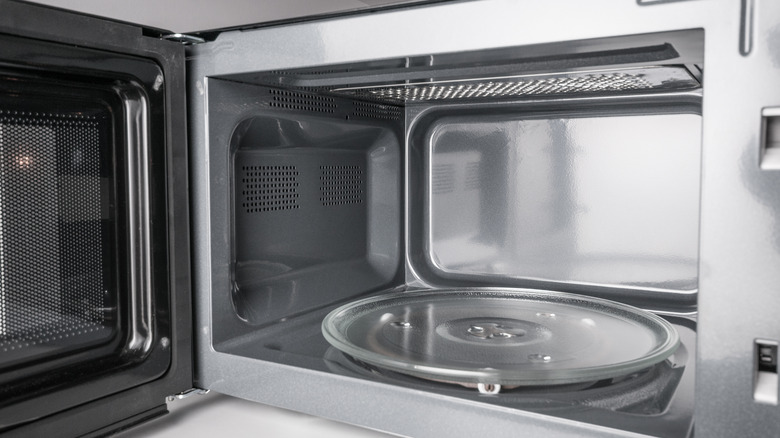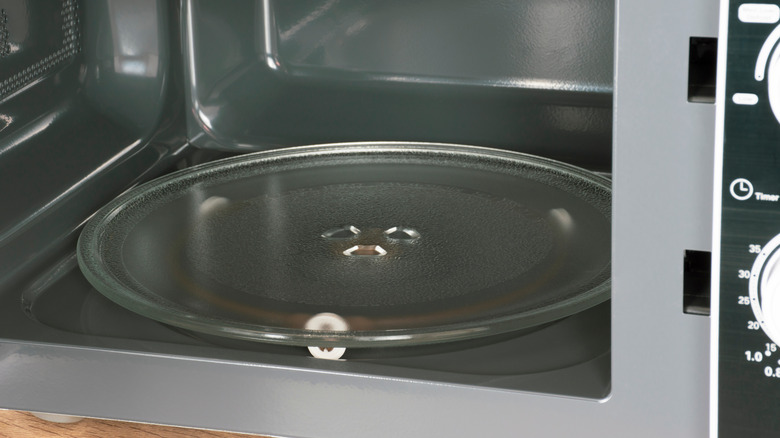Top Reasons Why Your Microwave Turntable Isn't Spinning
Whether you love or hate them, there is no denying that microwaves are very convenient in the kitchen. They heat meals quicker than a conventional oven, and you can also prep some quick bites in this appliance. Most microwaves come with a turntable where you place a bowl of food to warm up, and this turntable platter is designed to rotate to facilitate proper functioning. According to Viva Flavor, this rotating motion is necessary to enable even food heating by exposing every side of your leftovers to the heat.
Now when the turntable in your microwave stops rotating or is not as smooth in motion, you can see how this can create problems for you. Fortunately, fixing this problem doesn't always require the services of a repairman. If you can isolate the source of the problem successfully, you can DIY the solution right from home. While that is true, zeroing in on the source of the problem is easier said than done. For that reason, look at the following pointers that will help you get to the root of the problem and find the right solution.
Possible obstruction
One of the common reasons why the turntable platter inside your microwave fails to rotate is an obstruction on the roller track. Before panic-calling the repairman, the first place to investigate is below the turntable. Usually, the block is just a few particles of food that got into the track hence getting in the way of the turntable's motion. For this problem, you will need to remove the turntable platter and the roller guide to investigate what's going on underneath. Check if food particles are possibly making it difficult for the roller guide to move around.
While investigating, be sure also to test the individual spin of the turntable. According to GE appliances, a microwave can turn either clockwise or counterclockwise; therefore, it is necessary to make sure that the turntable doesn't get stuck in either direction. Fixing this problem is relatively easy; all you have to do is thoroughly clean the roller track and the coupler. Also, make it a habit to clean your microwave at least once every week or whenever there is food splatter inside, mentions Today.
Damage to the roller guide
If no visible food particles are causing an obstruction, the problem could be with the roller guide itself. The roller guide is positioned right underneath the turntable platter, facilitating the clockwise and anticlockwise motion thanks to its three wheels spaced evenly around the perimeter, via Easy Appliance Parts. With continuous use, the roller guide plastic wheels can experience wear and tear damage. Also, if the wheels have accumulated grime, they could quickly get stuck, limiting or even stopping the movement entirely.
While damage to a single wheel might not seem like much, it destabilized the platter inside the microwave. Isolating this problem will require you to remove the turntable platter and the roller guide and investigate. Spin each wheel individually to make sure they are spinning right. If the wheels have accumulated grime, clean them with warm soapy water. However, if a wheel is broken or the roller's frame is cracked, the best course of action is to find a suitable replacement.
Damage to the tray coupler
The tray coupler is the link between the drive motors and the circular tray, also referred to as the turntable platter, notes Martin Microwave Inc. They are connected to the circular tray by grooves positioned at the bottom of the tray. These grooves are specific to the microwave brand and the tray. Similar to most things inside the microwave, the grooves of the tray coupler are made of plastic. Because of wear and tear, the tray coupler grooves may get damaged causing them not to fit properly as they used to.
Begin by removing the turntable platter to expose the coupler, be sure to take a good look at the grooves and determine whether they are damaged or even melted. Also, if the coupler is full of grime, cleaning it might also help solve your problems. It is worth mentioning that the coupler is vital as far as the turntable movement is concerned. Therefore, if it doesn't fit well under the glass platter, it will compromise the action when the microwave is turned on. If it is damaged, your safest bet is to find a replacement part from the same brand.
Motor problems
If the turntable doesn't rotate, the problem could be with the drive motor. This is particularly true, especially if there are grinding noises every time the microwave runs, via Paradise Appliance. This device is the driving mechanism for most microwaves that have a turntable. Typically, motors break down because of wear and tear from years of service. The motor doesn't just stop working out of the blue; the movements slow down as the motor gradually grinds to a halt.
Because of the location of the motor, you will need to gain access through the bottom of the microwave. However, for a regular homeowner with limited handy skills, you might need to seek the services of a repairer. When your microwave motor stops working, the only solution is to find a replacement. However, if you have an old microwave that you have been using for close to seven years, per Mr. Appliance, buying a new appliance is a good idea.
Wrong replacement parts
As mentioned before, the coupler connects the tray and the motor, and they have a specific teeth pattern depending on the brand. So if you have just bought a used microwave and the turntable is not moving, the problem could be with the compatibility of the teeth connecting the turntable motor and the tray. Also, if the roller guide has been replaced with a different one, especially from a different brand, the turntable may have problems rotating inside the microwave. It is worth mentioning that while the roller guide and the tray may seem easy to remove and replace, they are precise to the machine and the microwave brand.
This information is critical whenever you need to replace any microwave part. Be sure to purchase replacement parts for your specific machine or from the same brand. This will go a long way in ensuring that you avoid future problems and unnecessary repairs. Furthermore, DelightedCooking mentions that you need to be extra careful when buying a used microwave because of the risk of purchasing an old, broken appliance.





